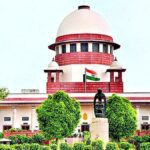The judicial appointments of escalation of judges to the Supreme Court and The High Courts are persistently met with controversy and debate. These judicial appointments are made as a recommendation of the Collegium System which currently comprises of the Chief Justice D.Y. Chandrachud, Justices Sanjay Kishan Kaul, and K.M. Joseph. There have been several instances when this system has come under the scanner and the most recent instance has been the nomination of Advocate Lekshaman Chandra Victoria Gowri for judgeship at the Madras High Court. To understand the issue better we shall first attempt to understand the Collegium System and the debate surrounding the establishment of the National Judicial Appointment Commission.
The Collegium System-
As per the constitution of India, the President appoints the Chief Justice of India and the remaining judges of the Supreme Court in consultation with the CJI and other judges as he deemed necessary. Until 1973, there existed a consensus between the Government and the Chief Justice of India regarding the appointment of judges. However, the superseding by Justice A.N. Ray of three senior Supreme Court judges in 1973 resulted in a clash between the Executive and the Judiciary. There were three landmark judgments that followed namely the First Judges Case in 1982 where the Supreme Court clarified that the word “consultation” in Article 124 of the Constitution did not imply concurrence and thus the President was not bound to decide based on the consultation of the Supreme Court. However, in the Second Judges Case in 1993 the Supreme Court overruled the earlier verdict. It changed the meaning of ‘consultation’ to ‘concurrence’ and this resulted in the birth of the Collegium System. During the Third Judges Case in 1998, there were questions on the meaning of the word consultation in articles 124, 217, and 222 of the Constitution and it was decided that under this Collegium System, the Chief Justice would not be the only one as a part of this consultation process rather the consultation would include a collegium of 4 senior-most judges of the Supreme Court. And thereafter, the Collegium came to be in the form it functions today.
The Collegium System today recommends the names of the candidates to the Central Government and further even the Central Government sends the names of the proposed candidates for consultation. There is no fixed time limit for the appointment process and if the Collegium resends the same names again to the government, it must give its assent to the names.
Issues with the Collegium System-
The exclusion of the executive from the judicial appointment process created a system where a handful of judges appoint the rest of the judges in complete secrecy. Furthermore, they are not accountable to any administrative body which may lead to the wrong choice of candidate giving rise to non-transparency of the judicial system. Secondly, there are no fixed specific criteria for testing the candidates for the post of the CJI thus leaving scope for nepotism and favoritism which is already viewed as one of the intrinsic concerns of the judicial system. These factors not only violate the principle of checks and balances but present the judiciary with unsupervised immense power as this is a closed-door affair and there exist no official minutes of the collegium proceedings or rather any public knowledge of its functioning.
National Judicial Appointment Commission-
There had been an attempt of replacing this system with a National Judicial Appointment Commission (“NJAC”). It would have comprised of The Chief Justice of India, 2 senior-most judges of the SC, The Law Minister of India, and 2 eminent members chosen by the Selection Committee. Though this system however was struck down by the Supreme Court in 2015 based on the grounds that it posed a threat to the independence of the judiciary.
The Collegium vs NJAC debate
The most recent debate regarding the Collegium and NJAC was reignited due to the comments by the current Law Minister Justice Kiren Rijiju’s remarks regarding the opaqueness of the appointments. The sentiment was shared by the Vice President and the Chairman of Rajya Sabha who felt that it was never too late to reflect on NJAC and its striking down was a “severe compromise of parliamentary sovereignty and disregard of the mandate of the people.” The Top Court however reasserted that it was the final arbiter of the law under the Constitutional scheme and as per the law the Government will have to appoint all the names reiterated by its Collegium.
This understanding circles us back to the current controversy surrounding Advocate Lekshmana, wherein a group of advocates have raised an alarm of over her elevation since by her own admission she is the general secretary of the Bharatiya Janata Party Mahila Morcha. In light of her political affiliations, instances of her ‘hate speech’ against religious minorities particularly Muslims and Christians have been brought forth. The Madras High Court Bar members feel that Gowri’s regressive views are completely unethical to the foundational constitutional values and reflect her deep-rooted religious bigotry thus making her unfit to be appointed as a High Court judge. It is also seen as rather disturbing that a person who harbors strong antipathy towards the minority community received the Collegium’s recommendation. Her remarks on Christians and Muslims as cited in a few articles and interviews in an RSS publication strongly deter any litigant belonging to the Muslim or Christian community from having any hope to receive justice in her court.
Such recommendations by the Collegium System lead us to argue whether, under the garb of a non-transparent veil, the current system has the power to erode the public confidence in the independence of the Judiciary.
By- Vartika Jain
[ 2nd Year Student at Jindal Global Law School ]



